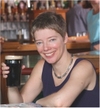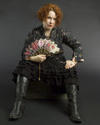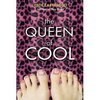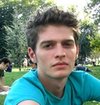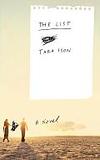WBBT Stop: Christopher Barzak
 Christopher Barzak‘s debut novel One for Sorrow
Christopher Barzak‘s debut novel One for Sorrow![]() was released in late August to a flurry of praise in the Village Voice, Washington Post, and San Francisco Chronicle, and cries of joy throughout the blogosphere. But, for years now, discerning readers of short fiction have kept a watch for new Barzak stories. His next novel–The Love We Share Without Knowing–recently sold to Bantam, and more on that in a moment. And I’m not even going to get into how he’s one of the hands-down best people you’ll ever encounter (not to mention a fine master of ceremonies). It’s probably best if I let you get charmed by him yourself, so…
was released in late August to a flurry of praise in the Village Voice, Washington Post, and San Francisco Chronicle, and cries of joy throughout the blogosphere. But, for years now, discerning readers of short fiction have kept a watch for new Barzak stories. His next novel–The Love We Share Without Knowing–recently sold to Bantam, and more on that in a moment. And I’m not even going to get into how he’s one of the hands-down best people you’ll ever encounter (not to mention a fine master of ceremonies). It’s probably best if I let you get charmed by him yourself, so…
GB: I can’t ask you the process question because you already answered it for me. So… where do you get your ideas? Kidding, kidding. You and I have talked a lot about how place and where you’re from impact your work. Can you speak a bit about that? One of the things I love about One for Sorrow is that it has that element of a kid coming to terms with where he grew up, in all its complexity.
CB: Place has always been one of the elements of fiction that I’ve enjoyed as a reader, so it’s no surprise to me that it’s one of the things I tend to gravitate toward as a writer. In the case of One for Sorrow, I set the book in a fictional small town in rural Ohio which bears a lot of similarities to the one in which I grew up. I didn’t name it for a couple of reasons. I wanted to be able to use place names and local anecdotes from a variety of neighboring villages and townships as well, so it became its own town in the novel, one part imagined, one part experienced, and one part observed. Growing up in a rural town was really a great experience in a lot of ways, to be honest. Being able to know just about everyone and some part of their story gives the world a sense of coherence and meaningfulness, I suppose. You’re able to be more certain of people and things, or at least you’re able to hold the illusion of certainty more easily. When I left home to go to college, I quickly discovered that I had been brought up to live a very particular kind of life, though, and that much of what I’d been taught about "how things are in the world" really only held true for where I’d come from. And on top of this, where I went for college was to a university in a dead steel town, Youngstown, Ohio. As I tell friends who sometimes ask why on earth I ever went there, it was where I could afford to go, it was the nearest "city" to where I’d grown up, and frankly it looked like a city to someone who grew up on a farm. It had a downtown with buildings over five stories tall, and a bus system, and a college, and parks. I think for a lot of people "city" conjures up Manhattan and Chicago and LA, but for me a limping along ghost town seemed pretty big. Again, when I left college and traveled a bit outside of Ohio and lived in other places, I got a better sense of how others lived. I mean, I’d of course seen the general standard of suburban America on television, but it never really felt real to me. When I started writing seriously, I decided I wanted to write about the places where I’d grown up and lived long enough to call home, to have lived there long enough to know them well. I wanted the region I came from to have books and stories they could read and say, "Hey! I know where that bridge is!" Or, "That’s that old church on Elm that’s falling down, isn’t it?" I wanted people from where I’m from to be able to pick up a book and find the place where they live in a story, because story is a powerful thing, and if you can’t find yourself in them you start to feel like maybe where you come from makes you unimportant. Literature has this validating effect on people. Certain places are often used as settings over and over. So I wanted to bring a voice from this abandoned corner of working class Ohio to the pages of books. In some ways, I think it may feel anachronistic to some readers, and it is anachronistic in a way, because this area is a place that was left behind. We’re still trying to catch the boat to the twenty first century. Hopefully someone will wait till we can get on board.
GB: One for Sorrow is being published as an adult book (as it should be), but it’s definitely a title with cross-over appeal for YA readers. It’s particularly refreshing to see a book that portrays teen sexuality in a realistic way. How did you approach that?
CB: Honestly, my approach to portraying teen sexuality was basically just trying to capture that whole awkwardness and scariness that fumbling toward figuring out this very adult thing that, let’s face it, we all know exists from a very early age. I knew that some people would be put off by fifteen-year-olds having sex of any kind in a book, but I think that kind of reader sees the novel as a strictly moral device, and anything in them is somehow condoned by the author. But the novel isn’t always about "instructing". It can be about portraying, and above all else I want my books to be honest in their portrayal of anything, sex included. For teenagers, they’ve been hearing about and seeing sex in a variety of forms–older siblings, school friends, media, church youth group leaders, etc–for a long time by the time they even get to the point of experimenting, so there’s this whole buildup to the thing that makes it extremely fraught. And also a lot of what they’ve heard or been told is just wrong (because so many parents fail to talk about the reality of sex with their kids at all, and think that is a much better way to prepare their children for the adult world–thanks Mom and Dad!) so there’s a bit of a pleasant surprise to finding out what it is, too, I think. Pleasant surprises, anxieties, fear–I wanted to try to gauge all of those things, especially in the one scene I think most readers are referring to when they talk about the portrayal of teen sexuality in One for Sorrow. It’s a really innocent scene in a lot of ways, I think, actually. And I don’t think it ends with a loss of that innocence, as so many narratives in which teens have sex will have us think happens as a matter of course.
GB: You recently sold your second novel, The Love We Share Without Knowing, and it sounds thoroughly different from One for Sorrow. Can you give us a little preview of what to expect?
CB: The Love We Share Without Knowing is definitely different than One for Sorrow, but I do think at its core it shares something in common. At its heart, it’s a ghost story, too. It’s told from multiple points of view though: an American teenager whose family has moved to Japan for his father’s job, the members of a Japanese suicide club, an American teacher of English who lost her lover in 9/11, a Japanese man who is mysteriously blinded after witnessing a blind man recover his sight on a train, a group of American ex-patriots all clinging to each other for comfort and familiarity in a foreign culture, and a young Japanese woman who may be a ghost or something more than human–she’s the crux of the narrative, I think, around which all the others and their lives spin. It’s about love, and loss, and how we’re all connected, even if we don’t realize it. Because of the multiple narrators, it ranges through a variety of genres of storytelling and voices. In recent years I really enjoyed novels that used this mosaic structure–David Mitchell’s Ghostwritten, Kevin Brockmeier’s The Truth About Celia, Dan Chaon’s You Remind Me of Me, and Michael Cunningham’s The Hours and Specimen Days–so when I began work on this second novel while I was living in Japan, I decided to try my hand at using a structure like the ones they created. It was a lot of fun, and delivers a completely different narrative pleasure than the one you get from writing a novel in one point of view for the entire trip, like I did with Adam in One for Sorrow.
GB: What are you working on right now? Any short stories due out soon?
CB: Right now I’ve just finished a long short story called "The Ghost Hunter’s Beautiful Daughter" and I’m working on a third novel, which I’m tentatively calling Yesterday’s Child. I have a story due out in the Solaris Book of New Fantasy this December, and another coming up next Fall in Sharyn November’s anthology Firebirds Soaring. There are other stories forthcoming, but they’re far enough down the road that I’m not even sure when the books in which they’ll appear will be released.
GB: And now, the most important question of all. What’s your favorite karaoke number Right This Second?
CB: Oh wow, just one?!? I need three and am going to ruthlessly take the space to list them. "Big Girl’s Don’t Cry" by Fergie. "The Origin of Love" from Hedwig and the Angry Inch. And always, always "Under the Bridge" by the Red Hot Chili Peppers!
Visit today’s other WBBT sites:
Lisa Ann Sandell at Chasing Ray
Perry Moore at Interactive Reader
Autumn Cornwell at The Ya Ya Yas
Jon Scieszka at Seven Impossible Things Before Breakfast
Gabrielle Zevin at Jen Robinson’s Book Page
Judy Blume at Not Your Mother’s Book Club
Erik P. Kraft at Bookshelves of Doom
Clare Dunkle at Miss Erin
WBBT Stop: Christopher Barzak Read More »
